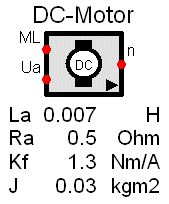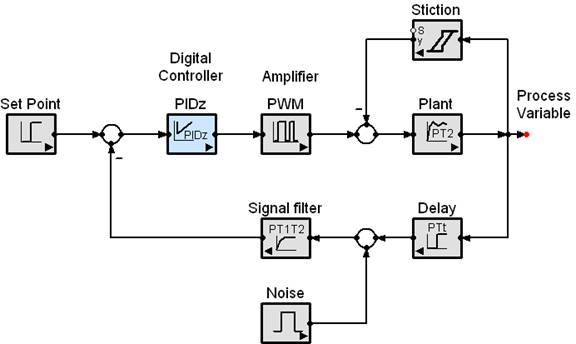 |
|||||||||||||
|
Everything should be made as simple as possible, but not simpler.
- Albert Einstein |
SimApp - Product DescriptionSimulation SoftwareSimApp is dynamic simulation software for modeling systems in the time and frequency domains. SimApp offers significant simulation power at a reasonable price, while reducing learning time. Once the dynamic behavior is understood, changes to the system can be made or control systems can be designed to make the system perform as desired. Simulation is ideal for control systems engineering or for students learning control theory for the first time. It can also be used in many other physical sciences or mathematical modeling environment. The computer simulation model is built visually through block diagrams. These signal-flow diagrams can represent a virtually unlimited range of systems. Models begin as ordinary differential equations or Laplace tranforms. You may also elect to represent models in a matrix state-space form (continuous or discrete), or as difference equations for digital controllers. SimApp works equally well to evaluate analog feedback control systems, digital control for processor-based systems, or hybrid systems. The figure below shows a system that is often found in industry – for example, a motion control system to move material in a manufacturing process.
SimApp contains many features that help you grow the model sophistication to the level needed for realistic results. Non-linear elements and custom inputs bring reality to the models. SimApp can also help you hide model complexity by building commonly used elements or subsystems into custom blocks. In this way you can also make SimApp your own - and uniquely tune it for your field of expertise. Time plots show the operation of your system at any point, as if you had connected an instrument to it. Plots can be made of the system over time to measure responses to external stimuli. Probes can be placed anywhere in the model and the results can be graphed or viewed in table form. Model results can be copied for use by other applications. Dynamics and control analysis can be performed in the frequency domain (Bode and Nyquist plots, Eigenvalues). This helps you determine stability of the system and evaluate strategies for optimization of performance. The SimApp DesktopThe SimApp Desktop is intuitive and well organized to make simulation modelling easy. You simply select the elements you want to use at the top menu and place them on the diagram. The blocks are easily connected via signal lines. In this example, a simple control system is diplayed. Diagrams created in SimApp are easy to copy to your document applications. You can open and work on several SimApp models at one time.  SimApp FeaturesContents (you can scroll down or click on the links below)
Simulation in the time domainSimApp provides a numerical simulation that shows responses to inputs over time. Input sources for the dynamic system include constants, sine waves, step functions, and user-defined profiles. Groups of system responses can be overlaid on a single diagram SimApp is designed for mathematical modeling of the following types of systems:
The output data are listed in tables tables and plotted in scalable time diagrams and x/y graphs. A movable cursor is available for signal measurements. The results can be stored with the block diagram. Simulation in the frequency domainFor linear and time-invariant systems, SimApp creates Bode- and Nyquist diagrams and a table with the characteristic values (eigenvalues or poles) of the evaluated system. Frequency probes measure the system at desired points. Frequency response plots can show open loop and closed loop behavior on one Bode Plot. Control design stability and performance can rapidly be examined with this method. Standard block diagram elementsSimApp has many basic blocks that can be selected by clicking on them. They are interconnected by wires to make complete systems. Most basic blocks have two alternative symbols. They show an icon of the response, or the mathematical representation of the transfer function. To review a list of functions, start a trial or review them here List of functions
Powerful featuresWhile SimApp is simple to use and learn it offers many features to help you model real-world systems. Non-linear elements and custom blocks are just two of these capabilities. Non-linear elementsExamples of a few non-linear elements useful for mechanical, electrical or chemical systems.
Examples of elements to simulate digital controllers
Built-in ControllersA variety of controllers is available to simplify control design. PID control is widely used in industrial applications. There are several variants of Proportional-Integral-Derivative ( PID ) controllers in the Controller palette. Some examples are shown in the figure below  Custom blocksMany standard blocks are available to build models. In practice, however, you may find that you reuse custom subsystems in various simulation models with different parameter values. For example, a DC motor can be summarized as:  You may also wish to condense large models into subsystems for clarity. With SimApp you can do both. You can select several objects in the drawing (block diagram elements or drawing objects) and transform them into one single block. All interconnections inside the group and to external blocks are preserved. All parameters of the included blocks appear under the new block symbol. You can design your own custom block icon, and this block can be accessed from the palette as if it were a basic block. This powerful capability allows you to build models that are simple to understand, and yet can scale your model to larger systems. Extending SimAppYou can build new objects and show them on the palette or in libraries to uniquely customize SimApp for your needs. They behave as standard toolbars and can be stored on disk and distributed to other users. Selected objects or groups of objects can easily be moved or copied to the palette or into an open library. In this way you can customize SimApp to many application areas. Drawing capabilitiesSimApp has extensive drawing facilities for creation of block diagrams, custom items, and documentation. You can transfer the drawings via the Windows clipboard to other applications. System requirementsSimApp runs on IBM compatible personal computers with Windows 2000/XP/Vista/Windows 10 and 11.
| ||||||||||||
| About Us | Contact Us | Privacy Policy | |||||||||||||












